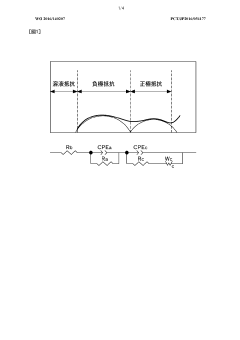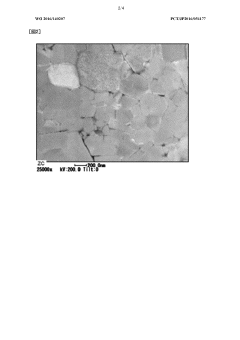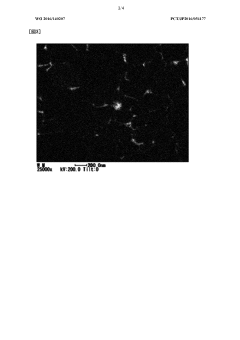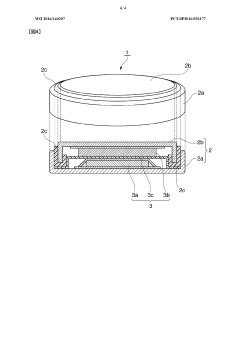Tungsten And The Future Of Electric Vehicle Batteries
Tungsten in EV Batteries: Background and Objectives
Tungsten, a metal known for its exceptional strength and high melting point, has recently emerged as a potential game-changer in the realm of electric vehicle (EV) batteries. The evolution of EV technology has been primarily driven by advancements in battery performance, with a focus on increasing energy density, reducing charging times, and enhancing overall efficiency. In this context, tungsten presents a promising avenue for addressing some of the key challenges faced by current lithium-ion battery technologies.
The primary objective of exploring tungsten in EV batteries is to overcome the limitations of existing battery chemistries, particularly in terms of energy density and fast-charging capabilities. Tungsten's unique properties, including its high thermal and electrical conductivity, make it an attractive candidate for improving battery performance. By incorporating tungsten into battery components, researchers aim to enhance the overall stability and longevity of EV batteries, potentially revolutionizing the electric automotive industry.
The historical development of EV batteries has seen a progression from lead-acid to nickel-metal hydride, and currently to lithium-ion technologies. Each iteration has brought improvements in energy density and cycle life, but the demand for even better performance continues to grow. Tungsten's integration into battery technology represents the next step in this evolutionary process, with the potential to address the increasing demands of the EV market.
One of the key drivers behind the exploration of tungsten in EV batteries is the growing need for faster charging times without compromising battery life or safety. Current fast-charging technologies often lead to accelerated degradation of battery components, reducing the overall lifespan of the battery. Tungsten's thermal properties could potentially mitigate these issues, allowing for more rapid charging while maintaining battery integrity.
Furthermore, the investigation into tungsten-based battery technologies aligns with the broader trend of seeking alternative materials to reduce reliance on rare earth elements and other critical materials that are subject to supply chain vulnerabilities. This aspect of tungsten research is particularly significant in the context of global efforts to create more sustainable and resilient EV battery supply chains.
As we delve deeper into the potential of tungsten in EV batteries, it is crucial to consider the technical challenges that must be overcome, such as optimizing tungsten's integration into existing battery architectures and scaling up production processes. The success of tungsten in EV batteries could not only enhance vehicle performance but also contribute to the broader goals of electrification and decarbonization in the transportation sector.
EV Battery Market Demand Analysis
The electric vehicle (EV) battery market is experiencing unprecedented growth, driven by the global shift towards sustainable transportation. As governments worldwide implement stricter emissions regulations and consumers become more environmentally conscious, the demand for EVs and their batteries continues to surge. This trend is reflected in the rapidly expanding market size, which is projected to reach significant values in the coming years.
The demand for EV batteries is closely tied to the overall EV market growth. Major automotive manufacturers are increasingly committing to electrification strategies, with many announcing plans to phase out internal combustion engine vehicles in favor of electric models. This transition is creating a substantial and sustained demand for high-performance batteries.
Consumer preferences are also shifting towards EVs, driven by factors such as improved battery technology, extended driving ranges, and decreasing costs. As battery performance improves and costs decline, EVs are becoming more accessible to a broader range of consumers, further fueling market demand.
The EV battery market is not limited to personal vehicles. There is growing demand in commercial and public transportation sectors, with electric buses, trucks, and other fleet vehicles gaining traction. This diversification of applications is expanding the overall market potential for EV batteries.
Geographically, the demand for EV batteries varies across regions. China remains the largest market, driven by strong government support and a robust domestic EV industry. Europe is experiencing rapid growth, propelled by stringent emissions regulations and incentives for EV adoption. The North American market is also expanding, with increasing consumer interest and supportive policies in certain states.
The demand for specific battery chemistries is evolving. While lithium-ion batteries currently dominate the market, there is growing interest in alternative technologies that offer improved performance, safety, and sustainability. This includes advanced lithium-ion formulations, solid-state batteries, and other emerging technologies.
Raw material supply and pricing play a crucial role in shaping market demand. The availability and cost of key materials such as lithium, cobalt, and nickel can impact battery production and, consequently, EV adoption rates. This has led to increased focus on developing batteries with alternative materials and improving recycling technologies to ensure a sustainable supply chain.
Current Challenges in Tungsten-based EV Batteries
Despite the promising potential of tungsten-based batteries for electric vehicles, several significant challenges currently hinder their widespread adoption and commercialization. These obstacles span technical, economic, and environmental domains, requiring comprehensive solutions before tungsten can become a viable alternative to existing battery technologies.
One of the primary technical challenges is the relatively low energy density of tungsten-based batteries compared to lithium-ion counterparts. While tungsten offers advantages in terms of stability and safety, it struggles to match the energy storage capacity of lithium-ion batteries, which is crucial for extending the range of electric vehicles. This limitation necessitates further research and development to enhance the energy density without compromising other beneficial properties.
Another significant hurdle is the high cost associated with tungsten extraction and processing. Tungsten is a relatively rare metal, and its mining and refining processes are energy-intensive and expensive. This economic factor poses a substantial barrier to the mass production and adoption of tungsten-based batteries, as it directly impacts the overall cost of electric vehicles.
The manufacturing complexity of tungsten-based batteries presents additional challenges. The production process requires specialized equipment and expertise, which are not yet widely available in the battery industry. This lack of established manufacturing infrastructure and know-how contributes to higher production costs and slower scalability compared to more mature battery technologies.
Environmental concerns also play a role in the challenges facing tungsten-based batteries. While tungsten itself is considered less environmentally harmful than some battery materials, the mining and processing of tungsten can have significant environmental impacts. Addressing these concerns through sustainable mining practices and efficient recycling methods is crucial for the long-term viability of tungsten-based batteries.
The integration of tungsten-based batteries into existing electric vehicle designs poses another challenge. Current EV architectures are optimized for lithium-ion batteries, and significant redesigns may be necessary to accommodate the different characteristics of tungsten-based systems. This adaptation process could be time-consuming and costly for automakers, potentially slowing down the adoption of this new technology.
Lastly, the lack of extensive real-world testing and long-term performance data for tungsten-based batteries in electric vehicles creates uncertainty among manufacturers and consumers. Without comprehensive data on factors such as cycle life, performance under various conditions, and long-term reliability, it becomes difficult to build confidence in this emerging technology.
Overcoming these challenges requires a concerted effort from researchers, manufacturers, and policymakers. Continued investment in research and development, along with strategic partnerships and government support, will be crucial in addressing these obstacles and realizing the potential of tungsten-based batteries in the electric vehicle market.
Existing Tungsten EV Battery Solutions
01 Tungsten deposition methods
Various methods for depositing tungsten on substrates, including chemical vapor deposition (CVD) and atomic layer deposition (ALD). These techniques are used to create thin films of tungsten for applications in semiconductor manufacturing and other industries.- Tungsten deposition methods: Various methods for depositing tungsten on substrates, including chemical vapor deposition (CVD) and atomic layer deposition (ALD). These techniques are used to create thin films of tungsten for applications in semiconductor manufacturing and other industries.
- Tungsten etching processes: Techniques for selectively removing tungsten from surfaces, often used in semiconductor fabrication. These processes may involve chemical etching, plasma etching, or a combination of methods to achieve precise patterning of tungsten layers.
- Tungsten-based alloys and composites: Development of tungsten alloys and composite materials that combine tungsten with other elements or compounds to enhance specific properties such as strength, conductivity, or thermal resistance. These materials find applications in various industries, including aerospace and electronics.
- Tungsten in electronic components: Use of tungsten in the manufacture of electronic components, particularly in the production of integrated circuits, interconnects, and other microelectronic devices. This includes the development of tungsten-based barrier layers and contact materials.
- Tungsten processing and recycling: Methods for processing raw tungsten ore, refining tungsten, and recycling tungsten-containing materials. This includes techniques for extracting tungsten from ores, purifying tungsten compounds, and recovering tungsten from scrap or waste materials.
02 Tungsten-based alloys and composites
Development of tungsten-based alloys and composite materials with enhanced properties, such as improved strength, hardness, and thermal stability. These materials find applications in aerospace, defense, and high-temperature industrial processes.Expand Specific Solutions03 Tungsten in electronic devices
Utilization of tungsten in electronic devices, particularly in the fabrication of integrated circuits and microelectronic components. This includes the use of tungsten as interconnects, gate electrodes, and diffusion barriers in semiconductor devices.Expand Specific Solutions04 Tungsten processing and recycling
Methods for processing tungsten ores, refining tungsten, and recycling tungsten-containing materials. These processes aim to improve the efficiency of tungsten production and reduce environmental impact through recycling and waste management.Expand Specific Solutions05 Tungsten surface treatment and modification
Techniques for modifying and treating tungsten surfaces to enhance their properties or compatibility with other materials. This includes methods for cleaning, etching, and functionalizing tungsten surfaces for various applications.Expand Specific Solutions
Key Players in Tungsten EV Battery Industry
The tungsten-based electric vehicle battery market is in its early growth stage, with significant potential for expansion as the automotive industry shifts towards electrification. The market size is expected to increase substantially in the coming years, driven by the demand for high-performance, long-range EV batteries. While the technology is still evolving, several key players are making strides in research and development. Companies like Toyota Motor Corp., Panasonic, and LG Electronics are investing heavily in tungsten-based battery technologies, leveraging their expertise in battery manufacturing. Academic institutions such as Beijing University of Technology and Central South University are contributing to fundamental research, while specialized materials companies like Sumitomo Metal Mining Co. Ltd. and Toshiba Materials Co., Ltd. are focusing on developing advanced tungsten-based materials for battery applications. The collaboration between industry and academia is accelerating the technology's maturation, positioning tungsten as a promising candidate for next-generation EV batteries.
Sumitomo Metal Mining Co. Ltd.
Toyota Motor Corp.
Core Innovations in Tungsten Battery Technology
- A method involving the addition of tungsten compounds, specifically lithium tungstate, to the lithium metal composite oxide powder, followed by a heat treatment process, to form a compound with tungsten on the surface of the primary particles, reducing positive electrode resistance and improving output characteristics.
- Attaching a tungsten compound and/or a molybdenum compound to the surface of lithium-containing transition metal oxides, specifically those with nickel as the main component, to reduce surface reaction resistance and enhance charge transfer reactions, thereby improving output characteristics across various temperature conditions.
Environmental Impact of Tungsten EV Batteries
The environmental impact of tungsten-based electric vehicle (EV) batteries is a critical consideration in the ongoing development of sustainable transportation technologies. Tungsten, known for its high melting point and durability, offers promising potential for enhancing battery performance. However, its extraction and processing raise significant environmental concerns that must be carefully evaluated.
Mining tungsten ore typically involves open-pit or underground operations, which can lead to habitat destruction, soil erosion, and water pollution. The extraction process often requires substantial energy inputs and may result in the release of harmful pollutants, including heavy metals and acid mine drainage. These environmental risks are particularly pronounced in regions where tungsten mining is concentrated, such as China, which accounts for over 80% of global tungsten production.
The refining and processing of tungsten for battery applications also present environmental challenges. The energy-intensive nature of tungsten production contributes to greenhouse gas emissions, potentially offsetting some of the environmental benefits associated with electric vehicles. Additionally, the use of chemicals in tungsten processing can generate hazardous waste streams that require careful management to prevent environmental contamination.
However, the environmental impact of tungsten EV batteries must be considered in the context of their potential benefits. If tungsten-based batteries can significantly improve energy density and longevity compared to current lithium-ion technologies, they could reduce the overall environmental footprint of EVs by extending battery life and reducing the frequency of battery replacements. This could lead to a decrease in raw material demand and associated environmental impacts over the long term.
Recycling and circular economy principles offer promising avenues for mitigating the environmental impact of tungsten EV batteries. Developing efficient recycling processes for tungsten-based battery components could reduce the need for primary tungsten extraction and minimize waste. However, the complexity of tungsten battery designs may present challenges for recycling efforts, necessitating innovative approaches to material recovery and reuse.
As the automotive industry continues to explore tungsten-based battery technologies, it is crucial to conduct comprehensive life cycle assessments to fully understand and quantify their environmental impacts. These assessments should consider not only the production and use phases but also end-of-life management and potential for recycling. Such analyses will be essential for informing policy decisions and guiding the development of more sustainable EV battery technologies.
Tungsten Supply Chain Analysis for EV Battery Production
The tungsten supply chain for electric vehicle (EV) battery production is a complex network involving multiple stages and stakeholders. The process begins with tungsten mining, primarily concentrated in China, Vietnam, and Russia. These countries account for over 80% of global tungsten production, with China being the dominant player, controlling approximately 80% of the world's tungsten supply.
Following extraction, the raw tungsten ore undergoes processing to produce tungsten concentrates. This stage involves crushing, grinding, and various separation techniques to isolate tungsten from other minerals. The concentrates are then converted into intermediate products such as ammonium paratungstate (APT) or tungsten oxide.
The next phase in the supply chain involves the production of tungsten powder, which is a crucial component in the manufacturing of EV battery electrodes. This process requires specialized equipment and expertise, with only a limited number of companies possessing the necessary capabilities. The majority of tungsten powder production facilities are located in China, further consolidating the country's control over the supply chain.
Tungsten powder is then incorporated into the production of EV battery components, particularly in the cathode materials. The integration of tungsten in battery technology is still in its early stages, with ongoing research and development efforts focused on optimizing its use to enhance battery performance and longevity.
The final stages of the supply chain involve the assembly of battery cells and packs, followed by their integration into electric vehicles. This process typically occurs in proximity to major automotive manufacturing hubs to minimize transportation costs and ensure efficient production.
Throughout the supply chain, various challenges and bottlenecks exist. These include geopolitical risks associated with the concentration of tungsten resources in a few countries, potential supply disruptions due to environmental regulations or trade disputes, and the need for sustainable and ethical sourcing practices. Additionally, the limited number of specialized processors and manufacturers in the tungsten supply chain creates potential vulnerabilities and dependencies.
To address these challenges, efforts are underway to diversify tungsten sources, develop alternative materials, and improve recycling technologies. The establishment of strategic partnerships and vertical integration strategies by EV manufacturers and battery producers is also becoming increasingly common to secure a stable supply of critical materials like tungsten.




